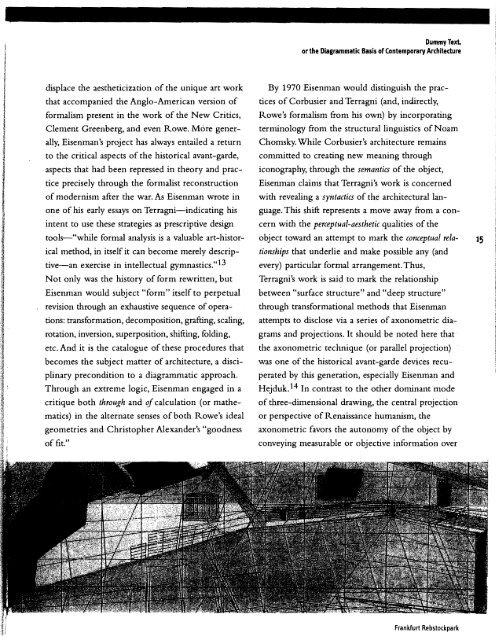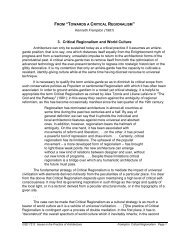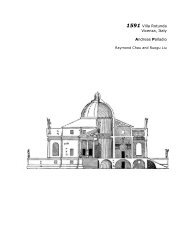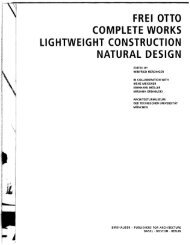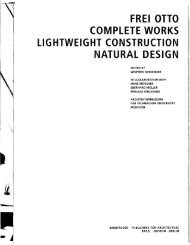Dummy Text, or The Diagrammatic - Introduction
Dummy Text, or The Diagrammatic - Introduction
Dummy Text, or The Diagrammatic - Introduction
Create successful ePaper yourself
Turn your PDF publications into a flip-book with our unique Google optimized e-Paper software.
displace the aestheticization of the unique art w<strong>or</strong>k<br />
that accompanied the Anglo-American version of<br />
f<strong>or</strong>malism present in the w<strong>or</strong>k of the New Critics,<br />
Clement Greenberg, and even Rowe. M<strong>or</strong>e gener<br />
ally, Eisenman's project has always entailed a return<br />
to the critical aspects of the hist<strong>or</strong>ical avant-garde,<br />
aspects that had been repressed in the<strong>or</strong>y and prac<br />
tice precisely through the f<strong>or</strong>malist reconstruction<br />
of modernism after the war. As Eisenman wrote in<br />
one of his early essays on Terragni-indicating his<br />
intent to use these strategies as prescriptive design<br />
tools-"while f<strong>or</strong>mal analysis is a valuable art-hist<strong>or</strong><br />
ical method, in itself it can become merely descrip<br />
tive-an exercise in intellectual gymnastics." 13<br />
Not only was the hist<strong>or</strong>y of f<strong>or</strong>m rewritten, but<br />
Eisenman would subject "f<strong>or</strong>m" itself to perpetual<br />
revision through an exhaustive sequence of opera<br />
tions: transf<strong>or</strong>mation, decomposition, grafting, scaling,<br />
rotation, inversion, superposition, shifting, folding,<br />
etc. And it is the catalogue of these procedures that<br />
becomes the subject matter of architecture, a disci<br />
plinary precondition to a diagrammatic approach.<br />
Through an extreme logic, Eisenman engaged in a<br />
critique both through and cif calculation (<strong>or</strong> mathe<br />
matics) in the alternate senses of both Rowe's ideal<br />
geometries and Christopher Alexander's "goodness<br />
<strong>Dummy</strong> <strong>Text</strong>.<br />
<strong>or</strong> the <strong>Diagrammatic</strong>: Basis of Contemp<strong>or</strong>ary Arc:hitedure<br />
By 1970 Eisenman would distinguish the prac<br />
tices of C<strong>or</strong>busier and Terragni (and, indirectly,<br />
Rowe's f<strong>or</strong>malism from his own) by inc<strong>or</strong>p<strong>or</strong>ating<br />
terminology from the structural linguistics of Noam<br />
Chomsky. While C<strong>or</strong>busier's architecture remains<br />
committed to creating new meaning through<br />
iconography, through the semantics of the object,<br />
Eisenman claims that Terragni's w<strong>or</strong>k is concerned<br />
with revealing a syntactics of the architectural lan<br />
guage. This shift represents a move away from a con<br />
cern with the perceptual-aesthetic qualities of the<br />
object toward an attempt to mark the conceptual rela<br />
tionships that underlie and make possible any (and<br />
every) particular f<strong>or</strong>mal arrangement. Thus,<br />
Terragni's w<strong>or</strong>k is said to mark the relationship<br />
between "surface stru'cture" and "deep structure"<br />
through transf<strong>or</strong>mational methods that Eisenman<br />
attempts to disclose via a series ofaxonometric dia<br />
grams and projections. It should be noted here that·<br />
the axonometric technique (<strong>or</strong> parallel projection)<br />
was one of the hist<strong>or</strong>ical avant-garde devices recu<br />
perated by this generation, especially Eisenman and<br />
Hejduk.14 In contrast to the other dominant mode<br />
of three-dimensional drawing, the central projection<br />
<strong>or</strong> perspective of Renaissance humanism, the<br />
axonometric fav<strong>or</strong>s the autonomy of the object by<br />
of fit." conveying measurable <strong>or</strong> objective inf<strong>or</strong>mation over<br />
Frankfurt Rebstockpark<br />
15


